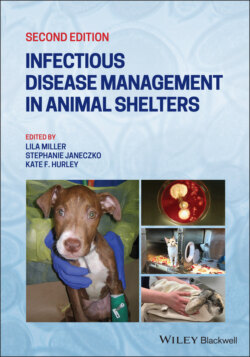Читать книгу Infectious Disease Management in Animal Shelters - Группа авторов - Страница 52
2.5.2 Parasite Control and Prevention
ОглавлениеParasite control and prevention represent essential components of shelter wellness programs. Wellness protocols for parasite control should be tailored to the given population, taking into account parasite prevalence, zoonotic potential, pathogenicity, cost, practicality, and safety. Both internal and external parasites are common in cats and dogs. Roundworms and hookworms are common intestinal parasites that possess zoonotic potential. Adult animals are often asymptomatic, whereas young puppies and kittens are most likely to exhibit clinical signs of infection, including diarrhea, anemia, and unthriftiness. The Centers for Disease Control and Prevention (CDC, www.cdc.gov) and the Companion Animal Parasite Council (CAPC, www.capcvet.org) strongly advise routine administration of broad‐spectrum anthelmintics to all cats and dogs to control these potential zoonoses. Pyrantel pamoate is one of the safest, most cost‐effective and efficacious anthelmintics for treatment of roundworms and hookworms. The author recommends the administration of pyrantel pamoate at a dosage of 10 mg/kg on entry to all adoptable cats and dogs with re‐treatment in two weeks and then at monthly intervals. Kittens and puppies should be treated at two‐week intervals until four months of age. For cats and dogs with diarrhea, a fecal flotation, direct fecal smear, and stained fecal cytology should be performed with treatment according to results. Even if results are negative, the administration of broad‐spectrum anthelmintics should be strongly considered unless definitive enzyme‐linked immunosorbent assay (ELISA) testing has confirmed the negative results. Ectoparasites, including fleas, ticks, lice, and mites (Otodectes, Notoedres, Sarcoptes, and Cheyletiella), are also common in cats and dogs entering shelters, and they require routine diagnosis and control measures. In addition to causing disease and discomfort in animals, some ectoparasites are responsible for transmitting zoonotic disease.
Heartworm disease is a serious vector‐borne disease that is caused by the mosquito‐borne filarial nematode Dirofilaria immitis. The testing of adoptable dogs over the age of six months is highly recommended in areas where canine heartworm disease is prevalent or dogs have been transported from areas with a high prevalence of heartworms, and when dogs exhibit clinical signs of the disease. Though cats can also be infected, heartworm testing is not recommended for cats due to the difficulty of interpreting the results. Shelters have adopted many strategies for testing, preventing and treating heartworm disease. Mosquito control is an essential component of any shelter heartworm prevention plan since D. immitis can be transmitted by over 70 species of mosquitoes. The ASV and the American Heartworm Society (AHS) worked together on a Heartworm Disease Resource Task Force to create a series of educational brochures that provide information to adopters about the disease (http://www.heartwormsociety.org 2017; http://www.sheltervet.org 2017). Downloadable, printable brochures help explain the shelter policy with regards to testing for and treating heartworms (i.e. whether a facility tests or treats the disease and which modalities are used) and recommendations for follow‐up with a local veterinarian. These brochures offer shelter staff a concise and accurate tool to facilitate communicating about this complex disease. Please see Chapter 18 for more information about heartworm disease.
The CAPC maintains excellent online resources (www.capcvet.org) including numerous detailed parasite guidelines, parasite prevalence maps, and product tables that are very useful for informing wellness protocols for shelters. Chapters 17 and 19 contain more information about internal and external parasites respectively.
